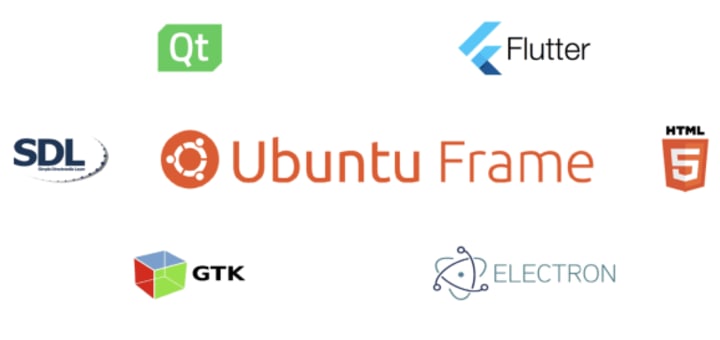

The journey from mir-kiosk to Ubuntu Frame
source link: https://ubuntu.com//blog/the-journey-from-mir-kiosk-to-ubuntu-frame
Go to the source link to view the article. You can view the picture content, updated content and better typesetting reading experience. If the link is broken, please click the button below to view the snapshot at that time.

We now deliver Ubuntu Frame, a display server for embedded devices that makes it easy for developers to deploy their graphics applications on Linux. Ubuntu Frame simplifies the development of embedded displays such as digital signage solutions, kiosks, IoT devices, robots, and more. In this blog, we will discuss the migration from mir-kiosk to Ubuntu Frame.
Goodbye mir-kiosk, hello Ubuntu Frame
Mir-kiosk was released in 2018. It provided a black screen with a mouse pointer, letting you run any application you want, instantly turning it into a kiosk application. It was designed to help people unlock a full kiosk mode for Linux embedded devices. And as such, it supported several projects on its way.
It was used in many devices around the world, including smart mirrors, point of sales in countrywide food chains, healthcare kiosks, and more. Since it was open source, our community also used mir-kiosk to develop exciting embedding applications, such as arcade consoles and smart hubs screens. And it is thanks to this production-grade experience, that we now deliver Ubuntu Frame.

Ubuntu Frame is the most reliable display server for embedded Linux systems as its technology has been in development for over 7 years and in production for 5 years. Ubuntu Frame bundles communication protocols, input protocols, and security policies into a single kit, which can then be used in embedded devices.
The main reason to create Ubuntu Frame was to provide the new generation of smart displays with the latest and greatest full-screen shell. Developments in the field, including our constant collection of developers’ needs, gave us the opportunity to refresh the foundation that we built with mir-kiosk. Ubuntu Frames distills what we’ve learned with our partners and adopters, and provides a solution that adjusts to current needs while future-proofing the development of this technology.
It also provides an improved experience from a developer and smart displays user’s perspective. New features, such as on-screen-keyboard, power-saving, and an easy configuration system are just some examples. The compatibility of graphics applications developed on the latest graphic toolkits and libraries, such as GTK, Qt, Flutter, and more, simplify the development of embedded displays.

From mir-kiosk to Ubuntu Frame
While mir-kiosk will remain maintained supporting current customers, we do recommend developers to start migrating to Ubuntu Frame. To support you in this process, we have detailed a process to achieve this migration. If you require commercial support, contact us.
Ubuntu Frame is open source, free to use, and long-term supported by Canonical, and will continue to be our recommended way to enable embedded graphics on Ubuntu Core.
How to contribute?
Ubuntu Frame is open source. This brings several advantages for developers and businesses. You don’t need to be a direct customer to have a say on this project. Even more, as the code is open, you can implement your own features. Its roadmap is publicly available, and our community can directly influence it.
You can get involved by:
- Reporting bugs: we want to know about the problems so we can fix them.
- Quality assurance: before releasing new features we make a “Call for Testing” a week prior to each update reaching “stable”. This is your opportunity to discover and report any problems.
- Documentation: there are lots of ways to use Ubuntu Frame and we try to describe the important ones, but maybe we missed yours.
- Feature requests: we have a lot of ideas on what to do next but you know what you need.
- Code changes: the code is open and we are open to accepting changes to it. So, don’t worry about maintaining a new fork, and instead, let’s work together.
Ubuntu Frame will continue growing with our community.
If you want to get involved, please visit our GitHub repository.
Learn more about Ubuntu Frame
Ready to simplify the development of embedded displays? Get started now:
Recommend
About Joyk
Aggregate valuable and interesting links.
Joyk means Joy of geeK